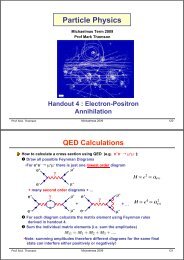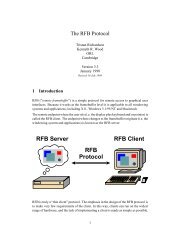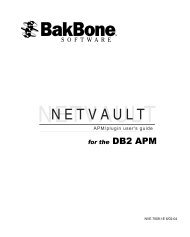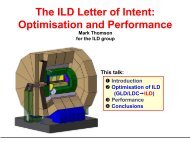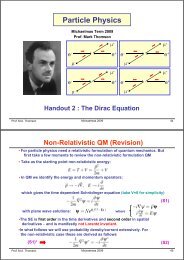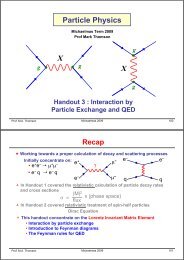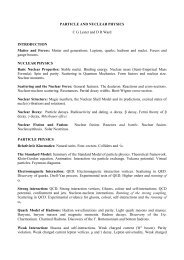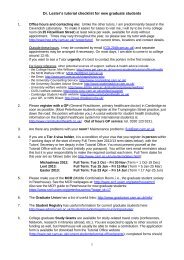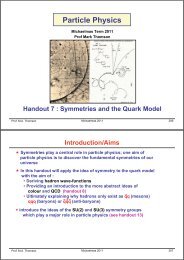Event Simulation for the LHC - High Energy Physics Group ...
Event Simulation for the LHC - High Energy Physics Group ...
Event Simulation for the LHC - High Energy Physics Group ...
You also want an ePaper? Increase the reach of your titles
YUMPU automatically turns print PDFs into web optimized ePapers that Google loves.
<strong>Event</strong> <strong>Simulation</strong> <strong>for</strong> <strong>the</strong><br />
Large Hadron Collider<br />
Bryan Webber<br />
Cavendish Laboratory<br />
University of Cambridge<br />
<strong>Event</strong> <strong>Simulation</strong> <strong>for</strong> <strong>the</strong> <strong>LHC</strong> 1<br />
IFT Colloquium, UAM, 04/04/13
<strong>Event</strong> <strong>Simulation</strong> <strong>for</strong> <strong>the</strong><br />
Large Hadron Collider<br />
• The Standard Model<br />
• Lepton-hadron and hadron-hadron collisions<br />
• <strong>Event</strong> generation, matching and merging<br />
• The Higgs boson<br />
• Beyond <strong>the</strong> Standard Model<br />
• Conclusions and prospects<br />
<strong>Event</strong> <strong>Simulation</strong> <strong>for</strong> <strong>the</strong> <strong>LHC</strong> 2<br />
IFT Colloquium, UAM, 04/04/13
The Standard Model<br />
Matter<br />
fermions<br />
Gauge<br />
bosons<br />
Scalar<br />
boson<br />
Electroweak<br />
SU(2)xU(1)<br />
QCD<br />
SU(3)<br />
<strong>Event</strong> <strong>Simulation</strong> <strong>for</strong> <strong>the</strong> <strong>LHC</strong> 3<br />
IFT Colloquium, UAM, 04/04/13
Lepton-Hadron<br />
Collisions<br />
<strong>Event</strong> <strong>Simulation</strong> <strong>for</strong> <strong>the</strong> <strong>LHC</strong> 4<br />
IFT Colloquium, UAM, 04/04/13
Deep Inelastic Scattering<br />
1fm↔ 0.2GeV<br />
e<br />
M p c 2 ≈ 1GeV<br />
u<br />
u<br />
~10 -15 m<br />
= 1 fm<br />
d<br />
<strong>Event</strong> <strong>Simulation</strong> <strong>for</strong> <strong>the</strong> <strong>LHC</strong> 5<br />
IFT Colloquium, UAM, 04/04/13
Deep Inelastic Scattering<br />
e<br />
u<br />
u<br />
d<br />
<strong>Event</strong> <strong>Simulation</strong> <strong>for</strong> <strong>the</strong> <strong>LHC</strong> 6<br />
IFT Colloquium, UAM, 04/04/13
Deep Inelastic Scattering<br />
e<br />
u<br />
u<br />
u<br />
u<br />
d<br />
<strong>Event</strong> <strong>Simulation</strong> <strong>for</strong> <strong>the</strong> <strong>LHC</strong> 7<br />
IFT Colloquium, UAM, 04/04/13
Deep Inelastic Scattering<br />
e<br />
u<br />
u<br />
u<br />
u<br />
d<br />
<strong>Event</strong> <strong>Simulation</strong> <strong>for</strong> <strong>the</strong> <strong>LHC</strong> 8<br />
IFT Colloquium, UAM, 04/04/13
Quark and Gluon<br />
(Parton) Distributions<br />
xf<br />
1<br />
0.8<br />
0.6<br />
0.4<br />
0.2<br />
xS<br />
H1 and ZEUS HERA I+II PDF Fit<br />
xd v<br />
xg<br />
xu v<br />
HERAPDF1.5 NNLO (prel.)<br />
exp. uncert.<br />
model uncert.<br />
2<br />
= 2 GeV<br />
parametrization uncert.<br />
0 0.2 0.4 0.6 0.8 1<br />
<strong>Event</strong> <strong>Simulation</strong> <strong>for</strong> <strong>the</strong> <strong>LHC</strong> 9<br />
IFT Colloquium, UAM, 04/04/13<br />
2<br />
Q<br />
Fraction of proton momentum<br />
x<br />
HERAPDF Structure Function Working <strong>Group</strong> March 2011<br />
Invariant 4-momentum<br />
transfer squared
Quark and Gluon<br />
(Parton) Distributions<br />
xf<br />
1<br />
0.8<br />
0.6<br />
0.4<br />
0.2<br />
xS<br />
H1 and ZEUS HERA I+II PDF Fit<br />
xd v<br />
xg<br />
xu v<br />
HERAPDF1.5 NNLO (prel.)<br />
exp. uncert.<br />
2<br />
Q<br />
model uncert.<br />
2<br />
= 10 GeV<br />
parametrization uncert.<br />
0 0.2 0.4 0.6 0.8 1<br />
Fraction of proton momentum<br />
x<br />
HERAPDF Structure Function Working <strong>Group</strong> March 2011<br />
<strong>Event</strong> <strong>Simulation</strong> <strong>for</strong> <strong>the</strong> <strong>LHC</strong> 10<br />
IFT Colloquium, UAM, 04/04/13
Quark and Gluon<br />
(Parton) Distributions<br />
xf<br />
1<br />
0.8<br />
0.6<br />
0.4<br />
0.2<br />
xS<br />
H1 and ZEUS HERA I+II PDF Fit<br />
xd v<br />
xg<br />
xu v<br />
HERAPDF1.5 NNLO (prel.)<br />
exp. uncert.<br />
model uncert.<br />
2<br />
Q<br />
parametrization uncert.<br />
2<br />
= 10000 GeV<br />
0 0.2 0.4 0.6 0.8 1<br />
Fraction of proton momentum<br />
x<br />
HERAPDF Structure Function Working <strong>Group</strong> March 2011<br />
<strong>Event</strong> <strong>Simulation</strong> <strong>for</strong> <strong>the</strong> <strong>LHC</strong> 11<br />
IFT Colloquium, UAM, 04/04/13
Deep Inelastic Scattering<br />
e<br />
u<br />
u<br />
d<br />
<strong>Event</strong> <strong>Simulation</strong> <strong>for</strong> <strong>the</strong> <strong>LHC</strong> 12<br />
IFT Colloquium, UAM, 04/04/13
Deep Inelastic Scattering<br />
e<br />
u<br />
u<br />
d<br />
<strong>Event</strong> <strong>Simulation</strong> <strong>for</strong> <strong>the</strong> <strong>LHC</strong> 13<br />
IFT Colloquium, UAM, 04/04/13
Deep Inelastic Scattering<br />
beam<br />
jet<br />
e<br />
<br />
p<br />
Hard scattering<br />
Gluon radiation<br />
Confinement<br />
quark jet<br />
Hadron <strong>for</strong>mation<br />
<br />
<strong>Event</strong> <strong>Simulation</strong> <strong>for</strong> <strong>the</strong> <strong>LHC</strong> 14<br />
IFT Colloquium, UAM, 04/04/13
HERA ep Collider<br />
• Located at DESY Hamburg<br />
• Electron-proton collisions at 318 GeV (Mpc 2 ~1 GeV)<br />
• Main experiments H1 and ZEUS<br />
• Closed June 2007<br />
<strong>Event</strong> <strong>Simulation</strong> <strong>for</strong> <strong>the</strong> <strong>LHC</strong> 15<br />
IFT Colloquium, UAM, 04/04/13
ZEUS Detector<br />
<strong>Event</strong> <strong>Simulation</strong> <strong>for</strong> <strong>the</strong> <strong>LHC</strong> 16<br />
IFT Colloquium, UAM, 04/04/13
ZEUS <strong>Event</strong> Display<br />
quark<br />
jet<br />
e<br />
<strong>Event</strong> <strong>Simulation</strong> <strong>for</strong> <strong>the</strong> <strong>LHC</strong> 17<br />
IFT Colloquium, UAM, 04/04/13
eam<br />
jet<br />
e<br />
<br />
Theoretical Status<br />
Exact fixed-order<br />
perturbation <strong>the</strong>ory<br />
Approximate all-order<br />
perturbation <strong>the</strong>ory<br />
Semi-empirical<br />
local models only<br />
Hard scattering<br />
Gluon radiation<br />
Confinement<br />
p<br />
quark jet<br />
Hadron <strong>for</strong>mation<br />
<br />
<strong>Event</strong> <strong>Simulation</strong> <strong>for</strong> <strong>the</strong> <strong>LHC</strong> 18<br />
IFT Colloquium, UAM, 04/04/13
Hadron-Hadron<br />
Collisions<br />
<strong>Event</strong> <strong>Simulation</strong> <strong>for</strong> <strong>the</strong> <strong>LHC</strong> 19<br />
IFT Colloquium, UAM, 04/04/13
Tevatron Collider<br />
• Located at Fermilab near Chicago<br />
• Proton-antiproton collisions at 1.96 TeV<br />
• Main experiments CDF and D0<br />
• Closed September 2011<br />
<strong>Event</strong> <strong>Simulation</strong> <strong>for</strong> <strong>the</strong> <strong>LHC</strong> 20<br />
IFT Colloquium, UAM, 04/04/13
Large Hadron Collider<br />
• Located at CERN near Geneva<br />
• Proton-proton collisions at 7 TeV (2011), 8 TeV (2012)<br />
• Main experiments ATLAS and CMS<br />
• Design energy 14 TeV<br />
<strong>Event</strong> <strong>Simulation</strong> <strong>for</strong> <strong>the</strong> <strong>LHC</strong> 21<br />
IFT Colloquium, UAM, 04/04/13
<strong>LHC</strong> Experiments<br />
<strong>Event</strong> <strong>Simulation</strong> <strong>for</strong> <strong>the</strong> <strong>LHC</strong> 22<br />
IFT Colloquium, UAM, 04/04/13
A Toroidal <strong>LHC</strong> ApparatuS<br />
Muon Detectors Tile Calorimeter Liquid Argon Calorimeters<br />
22 m<br />
46 m<br />
Toroid Magnets Solenoid Magnet SCT Tracker Pixel Detector TRT Tracker<br />
<strong>Event</strong> <strong>Simulation</strong> <strong>for</strong> <strong>the</strong> <strong>LHC</strong> 23<br />
IFT Colloquium, UAM, 04/04/13
ATLAS Muon Detector<br />
Man <strong>for</strong> scale<br />
<strong>Event</strong> <strong>Simulation</strong> <strong>for</strong> <strong>the</strong> <strong>LHC</strong> 24<br />
IFT Colloquium, UAM, 04/04/13
ATLAS Calorimeters and Central Solenoid<br />
Man <strong>for</strong> scale<br />
<strong>Event</strong> <strong>Simulation</strong> <strong>for</strong> <strong>the</strong> <strong>LHC</strong> 25<br />
IFT Colloquium, UAM, 04/04/13
ATLAS <strong>Event</strong> Display<br />
• Candidate <strong>for</strong> Higgs decay to e + e − µ + µ −<br />
<strong>Event</strong> <strong>Simulation</strong> <strong>for</strong> <strong>the</strong> <strong>LHC</strong> 26<br />
IFT Colloquium, UAM, 04/04/13
Compact Muon Solenoid<br />
@A*),(8)*>?)/B2<br />
84*)(+ C4
CMS <strong>Event</strong> Display<br />
• Candidate <strong>for</strong> Higgs decay to e + e − µ + µ −<br />
<strong>Event</strong> <strong>Simulation</strong> <strong>for</strong> <strong>the</strong> <strong>LHC</strong> 28<br />
IFT Colloquium, UAM, 04/04/13
<strong>LHC</strong> Collision<br />
<strong>Event</strong> <strong>Simulation</strong> <strong>for</strong> <strong>the</strong> <strong>LHC</strong> 29<br />
IFT Colloquium, UAM, 04/04/13
<strong>LHC</strong> Collision<br />
Dijet production<br />
<strong>Event</strong> <strong>Simulation</strong> <strong>for</strong> <strong>the</strong> <strong>LHC</strong> 30<br />
IFT Colloquium, UAM, 04/04/13
For small p t min and high energy inclusive parton—parton<br />
cross section is larger than total proton—proton cross<br />
section.<br />
Multiple Interactions<br />
! More than one parton—parton scatter per proton—proton<br />
• A Need feature a model of of hadron-hadron spatial distribution collisions, within protonnot<br />
present<br />
! Perturbation<br />
in lepton-lepton<br />
<strong>the</strong>ory gives n-scatter<br />
or lepton-hadron:<br />
distributions<br />
✤<br />
Multiple parton interactions in same collision<br />
• These give rise to extra hadron production<br />
✤<br />
<strong>LHC</strong> <strong>Simulation</strong>s 3<br />
Often called <strong>the</strong> underlying event<br />
Bryan Webber<br />
✤<br />
Not to be confused with pile-up (multiple<br />
proton collisions in same bunches)<br />
<strong>Event</strong> <strong>Simulation</strong> <strong>for</strong> <strong>the</strong> <strong>LHC</strong> 31<br />
IFT Colloquium, UAM, 04/04/13
<strong>LHC</strong> Collision<br />
quark jet<br />
beam<br />
jet<br />
p<br />
<br />
<br />
p<br />
beam<br />
jet<br />
quark jet<br />
Hard process<br />
Underlying event<br />
Gluon radiation<br />
Confinement<br />
Hadron <strong>for</strong>mation<br />
<strong>Event</strong> <strong>Simulation</strong> <strong>for</strong> <strong>the</strong> <strong>LHC</strong> 32<br />
IFT Colloquium, UAM, 04/04/13
A high-mass dijet<br />
Mjj=4 TeV<br />
G. Dissertori : Experimental Summary 44<br />
33<br />
<strong>Event</strong> <strong>Simulation</strong> <strong>for</strong> <strong>the</strong> <strong>LHC</strong> IFT Colloquium, UAM, 04/04/13
QCD Factorization<br />
σ pp→X (E 2 pp) =<br />
1<br />
0<br />
dx 1 dx 2 f i (x 1 ,µ 2 ) f j (x 2 ,µ 2 )ˆσ ij→X (x 1 x 2 E 2 pp,µ 2 )<br />
<br />
momentum<br />
fractions<br />
parton<br />
distributions<br />
at scale<br />
µ 2<br />
<br />
hard process<br />
cross section<br />
• Jet <strong>for</strong>mation and underlying event take place over a<br />
much longer time scale, with unit probability<br />
• Hence <strong>the</strong>y cannot affect <strong>the</strong> cross section<br />
• Scale dependences of parton distributions and hard<br />
process cross section are perturbatively calculable,<br />
and cancel order by order<br />
<strong>Event</strong> <strong>Simulation</strong> <strong>for</strong> <strong>the</strong> <strong>LHC</strong> 34<br />
IFT Colloquium, UAM, 04/04/13
Dijet Mass Distribution<br />
[ATLAS-CONF-2012-110]<br />
DIJETS IN 8 TEV DATA<br />
[CMS PAS EXO-12-016]<br />
<strong>Event</strong>s<br />
5<br />
10<br />
4<br />
10<br />
Data<br />
Fit<br />
!"#$@7#"&,&'$7A)67'8 9: ;<br />
3<br />
10<br />
<br />
s = 8 TeV<br />
L dt = 5.8 fb<br />
-1<br />
2<br />
10<br />
10<br />
1<br />
-1<br />
10<br />
ATLAS Preliminary<br />
Significance<br />
2<br />
0<br />
-2<br />
2000 3000 4000<br />
Reconstructed m jj<br />
2000 3000 4000<br />
Reconstructed m jj<br />
[GeV]<br />
• !"#$%&'()$'*+,"-'$".)/#/%"'+/'.0))-&12'(#11+/3'0#..'.4"%-$50<br />
• 5.8 fb-1 = 5.8 events per fb<br />
! "#$%&'()*#+),$--), ,, ).)/0123)4#5)678,)+7&((#7)$'%)8+9#7):8'-+7$&'+-<br />
• 1 fb =10-15 barn (1 barn = 10 -28 m 2 ~ nuclear size)<br />
• No sign of deviation from Standard Model (yet)<br />
! ;$:8'$")?+<br />
<strong>Event</strong> <strong>Simulation</strong> <strong>for</strong> <strong>the</strong> <strong>LHC</strong> 35<br />
IFT Colloquium, UAM, 04/04/13
Monte Carlo<br />
<strong>Event</strong> Generation<br />
<strong>Event</strong> <strong>Simulation</strong> <strong>for</strong> <strong>the</strong> <strong>LHC</strong> 36<br />
IFT Colloquium, UAM, 04/04/13
Monte Carlo <strong>Event</strong> Generation<br />
• Aim is to produce simulated (particle-level) datasets like<br />
those from real collider events<br />
✤ i.e. lists of particle identities, momenta, ...<br />
✤<br />
simulate quantum effects by (pseudo)random numbers<br />
• Essential <strong>for</strong>:<br />
✤<br />
✤<br />
✤<br />
✤<br />
Designing new experiments and data analyses<br />
Correcting <strong>for</strong> detector and selection effects<br />
Testing <strong>the</strong> SM and measuring its parameters<br />
Estimating new signals and <strong>the</strong>ir backgrounds<br />
<strong>Event</strong> <strong>Simulation</strong> <strong>for</strong> <strong>the</strong> <strong>LHC</strong> 37<br />
IFT Colloquium, UAM, 04/04/13
<strong>LHC</strong> <strong>Event</strong> Generation<br />
p<br />
p<br />
Hard process<br />
Underlying event<br />
Parton showers<br />
Confinement<br />
Hadronization<br />
Hadron decays<br />
<strong>Event</strong> <strong>Simulation</strong> <strong>for</strong> <strong>the</strong> <strong>LHC</strong> 38<br />
IFT Colloquium, UAM, 04/04/13
Parton Shower Approximation<br />
• Keep only most singular parts of QCD matrix elements:<br />
• Collinear dσ n+1 ≈ α <br />
S<br />
dξ i dφ i<br />
P ii (z i ,φ i ) dz i<br />
2π<br />
ξ<br />
• Soft dσ n+1 ≈ α i<br />
i 2π dσ n<br />
<br />
S<br />
p i · p j<br />
(−T i · T j )<br />
2π<br />
p i · kp j · k ωdωdξ dφ i<br />
i<br />
2π dσ n<br />
= α S<br />
2π<br />
≈<br />
α S<br />
2π<br />
i,j<br />
<br />
i,j<br />
(−T i · T j ) ξ ij<br />
ξ i ξ j<br />
dω<br />
ω dξ i<br />
<br />
(−T i · T j )Θ(ξ ij − ξ i ) dω ω<br />
i,j<br />
j<br />
dφ i<br />
2π dσ n<br />
dξ i<br />
ξ i<br />
dσ n<br />
ξ i =1− cos θ i<br />
θ ij >θ i<br />
i<br />
θ i<br />
ω =(1− z i )E i<br />
z i E i<br />
Angular-ordered parton shower<br />
<strong>Event</strong> <strong>Simulation</strong> <strong>for</strong> <strong>the</strong> <strong>LHC</strong> 39<br />
IFT Colloquium, UAM, 04/04/13
Cluster Hadronization Model<br />
• In parton shower, relative transverse momenta<br />
evolve from a high scale Q towards lower values<br />
• At a scale near LQCD~200 MeV, perturbation<br />
<strong>the</strong>ory breaks down and hadrons are <strong>for</strong>med<br />
Preconfinement<br />
• Be<strong>for</strong>e that, at scales Q0<br />
approximation: gluon = colour—anticolour<br />
~ few<br />
pair.<br />
x LQCD, <strong>the</strong>re is<br />
universal preconfinement of colour<br />
colour structure<br />
•<br />
of Decay parton of preconfined shower: colour-singlet clusters provides pairs a basis<br />
up close in phase <strong>for</strong> space hadronization models<br />
spectrum of colour-singlet pairs asymptotically<br />
<strong>Event</strong> <strong>Simulation</strong> <strong>for</strong> <strong>the</strong> <strong>LHC</strong> 40<br />
IFT Colloquium, UAM, 04/04/13
Cluster Hadronization Model<br />
• In parton shower, relative transverse momenta<br />
evolve from a high scale Q towards lower values<br />
• At a scale near LQCD~200 MeV, perturbation<br />
<strong>the</strong>ory breaks down and hadrons are <strong>for</strong>med<br />
Preconfinement<br />
• Be<strong>for</strong>e that, at scales Q0 ~ few x LQCD, <strong>the</strong>re is<br />
r approximation: gluon = colour—anticolour pair.<br />
universal preconfinement of colour<br />
colour structure<br />
•<br />
of Decay parton of preconfined shower: colour-singlet clusters provides pairs a basis<br />
up close in phase <strong>for</strong> space hadronization models<br />
spectrum of colour-singlet pairs asymptotically<br />
<strong>Event</strong> <strong>Simulation</strong> <strong>for</strong> <strong>the</strong> <strong>LHC</strong> 41<br />
IFT Colloquium, UAM, 04/04/13
Cluster Hadronization Model<br />
• In parton shower, relative transverse momenta<br />
evolve from a high scale Q towards lower values<br />
• At a scale near LQCD~200 MeV, perturbation<br />
<strong>the</strong>ory breaks down and hadrons are <strong>for</strong>med<br />
Preconfinement<br />
• Be<strong>for</strong>e that, at scales Q0 ~ few x LQCD, <strong>the</strong>re is<br />
r approximation: gluon = colour—anticolour pair.<br />
universal preconfinement of colour<br />
colour structure<br />
•<br />
of Decay parton of preconfined shower: colour-singlet clusters provides pairs a basis<br />
up close in phase <strong>for</strong> space hadronization models<br />
spectrum of colour-singlet pairs asymptotically<br />
<strong>Event</strong> <strong>Simulation</strong> <strong>for</strong> <strong>the</strong> <strong>LHC</strong> 42<br />
IFT Colloquium, UAM, 04/04/13
Cluster Hadronization Model<br />
• In parton shower, relative transverse momenta<br />
evolve from a high scale Q towards lower values<br />
• At a scale near LQCD~200 MeV, perturbation<br />
<strong>the</strong>ory breaks down and hadrons are <strong>for</strong>med<br />
Preconfinement<br />
• Be<strong>for</strong>e that, at scales Q0 ~ few x LQCD, <strong>the</strong>re is<br />
r approximation: gluon = colour—anticolour pair.<br />
universal preconfinement of colour<br />
colour structure<br />
•<br />
of Decay parton of preconfined shower: colour-singlet clusters provides pairs a basis<br />
up close in phase <strong>for</strong> space hadronization models<br />
spectrum of colour-singlet pairs asymptotically<br />
<strong>Event</strong> <strong>Simulation</strong> <strong>for</strong> <strong>the</strong> <strong>LHC</strong> 43<br />
IFT Colloquium, UAM, 04/04/13
Colour Preconfinement<br />
• Mass distribution of preconfined clusters is universal<br />
<strong>Event</strong> <strong>Simulation</strong> <strong>for</strong> <strong>the</strong> <strong>LHC</strong> 44<br />
IFT Colloquium, UAM, 04/04/13
Monte Carlo <strong>Event</strong> Generators<br />
• Traditionally (imprecise) general-purpose tools<br />
• Much recent work to make <strong>the</strong>m more precise<br />
<strong>Event</strong> <strong>Simulation</strong> <strong>for</strong> <strong>the</strong> <strong>LHC</strong> 45<br />
IFT Colloquium, UAM, 04/04/13
MC <strong>Event</strong> Generators<br />
HERWIG<br />
http://projects.hep<strong>for</strong>ge.org/herwig/<br />
Angular-ordered parton shower, cluster hadronization<br />
v6 Fortran; Herwig++<br />
PYTHIA<br />
http://www.<strong>the</strong>p.lu.se/∼torbjorn/Pythia.html<br />
Dipole-type parton shower, string hadronization<br />
v6 Fortran; v8 C++<br />
SHERPA<br />
http://projects.hep<strong>for</strong>ge.org/sherpa/<br />
Dipole-type parton shower, cluster hadronization<br />
C++<br />
“General-purpose event generators <strong>for</strong> <strong>LHC</strong> physics”,<br />
A Buckley et al., arXiv:1101.2599, Phys. Rept. 504(2011)145<br />
<strong>Event</strong> <strong>Simulation</strong> <strong>for</strong> <strong>the</strong> <strong>LHC</strong> 46<br />
IFT Colloquium, UAM, 04/04/13
Parton Shower Monte Carlo<br />
• Hard subprocess:<br />
q¯q → Z 0 /W ±<br />
http://mcplots.cern.ch/<br />
• Leading-order (LO) normalization need next-to-LO (NLO)<br />
• Worse <strong>for</strong> high pT and/or extra jets need multijet merging<br />
<strong>Event</strong> <strong>Simulation</strong> <strong>for</strong> <strong>the</strong> <strong>LHC</strong> 47<br />
IFT Colloquium, UAM, 04/04/13
Improving <strong>Event</strong> <strong>Simulation</strong><br />
Hard subprocess<br />
e.g.<br />
qq → Z 0 qq<br />
<strong>Event</strong> <strong>Simulation</strong> <strong>for</strong> <strong>the</strong> <strong>LHC</strong> 48<br />
IFT Colloquium, UAM, 04/04/13
Improving <strong>Event</strong> <strong>Simulation</strong><br />
NLO Hard subprocess<br />
(virtual correction)<br />
<strong>Event</strong> <strong>Simulation</strong> <strong>for</strong> <strong>the</strong> <strong>LHC</strong> 49<br />
IFT Colloquium, UAM, 04/04/13
Improving <strong>Event</strong> <strong>Simulation</strong><br />
NLO Hard subprocess<br />
(real emission)<br />
<strong>Event</strong> <strong>Simulation</strong> <strong>for</strong> <strong>the</strong> <strong>LHC</strong> 50<br />
IFT Colloquium, UAM, 04/04/13
Improving <strong>Event</strong> <strong>Simulation</strong><br />
NLO Hard subprocess<br />
+Parton showering<br />
= Double counting??<br />
<strong>Event</strong> <strong>Simulation</strong> <strong>for</strong> <strong>the</strong> <strong>LHC</strong> 51<br />
IFT Colloquium, UAM, 04/04/13
Improving <strong>Event</strong> <strong>Simulation</strong><br />
Multijet<br />
Hard subprocess<br />
<strong>Event</strong> <strong>Simulation</strong> <strong>for</strong> <strong>the</strong> <strong>LHC</strong> 52<br />
IFT Colloquium, UAM, 04/04/13
Improving <strong>Event</strong> <strong>Simulation</strong><br />
Multijet<br />
Hard subprocess<br />
+Parton showering<br />
= Double counting??<br />
<strong>Event</strong> <strong>Simulation</strong> <strong>for</strong> <strong>the</strong> <strong>LHC</strong> 53<br />
IFT Colloquium, UAM, 04/04/13
Matching & Merging<br />
• Two ra<strong>the</strong>r different objectives:<br />
• Matching parton showers to NLO matrix elements, without<br />
double counting<br />
✤<br />
✤<br />
MC@NLO<br />
POWHEG<br />
Frixione, BW, 2002<br />
Nason, 2004<br />
• Merging parton showers with LO n-jet matrix elements,<br />
minimizing jet resolution dependence<br />
✤<br />
✤<br />
✤<br />
CKKW<br />
Dipole<br />
MLM merging<br />
Catani, Krauss, Kühn, BW, 2001<br />
Lönnblad, 2001<br />
Mangano, 2002<br />
<strong>Event</strong> <strong>Simulation</strong> <strong>for</strong> <strong>the</strong> <strong>LHC</strong> 54<br />
IFT Colloquium, UAM, 04/04/13
MC@NLO matching<br />
S Frixione & BW, JHEP 06(2002)029<br />
• Compute parton shower contributions (real and<br />
virtual) at NLO<br />
✤<br />
Generator-dependent<br />
• Subtract <strong>the</strong>se from exact NLO<br />
✤<br />
Cancels divergences of exact NLO!<br />
• Generate modified no-emission (LO+virtual) and<br />
real-emission hard process configurations<br />
✤<br />
Some may have negative weight<br />
• Pass <strong>the</strong>se through parton shower etc.<br />
✤<br />
Only shower-generated terms beyond NLO<br />
<strong>Event</strong> <strong>Simulation</strong> <strong>for</strong> <strong>the</strong> <strong>LHC</strong> 55<br />
IFT Colloquium, UAM, 04/04/13
POWHEG matching<br />
P Nason, JHEP 11(2004)040<br />
• POsitive Weight Hardest Emission Generator<br />
•<br />
Use exact real-emission matrix element to generate<br />
hardest (highest relative pT) emission configurations<br />
✤<br />
✤<br />
✤<br />
No-emission probability implicitly modified<br />
(Almost) eliminates negative weights<br />
Some uncontrolled terms generated beyond NLO<br />
• Pass configurations through parton shower etc<br />
<strong>Event</strong> <strong>Simulation</strong> <strong>for</strong> <strong>the</strong> <strong>LHC</strong> 56<br />
IFT Colloquium, UAM, 04/04/13
Z 0 at Tevatron<br />
http://mcplots.cern.ch/<br />
• Absolute normalization:<br />
LO too low<br />
• POWHEG agrees with<br />
rate and distribution<br />
<strong>Event</strong> <strong>Simulation</strong> <strong>for</strong> <strong>the</strong> <strong>LHC</strong> 57<br />
IFT Colloquium, UAM, 04/04/13
pp → γγ at Tevatron Run II<br />
gg at Tevatron<br />
dσ/dp γγ<br />
⊥ /dM γγ [pb/GeV 2 ]<br />
10 −2 (a) 50 GeV< M γγ
W asymmetry at <strong>LHC</strong><br />
n II, pp → W → l ¯ν at <strong>LHC</strong> 7 TeV<br />
φ ∗ η<br />
Aµ<br />
MC/data<br />
0.3<br />
0.25<br />
0.2<br />
0.15<br />
0.1<br />
0.05<br />
0<br />
1.4<br />
1.2<br />
1<br />
0.8<br />
0.6<br />
Muon charge asymmetry in W decays<br />
ATLAS data<br />
Herwig++ LO<br />
Herwig++ Powheg<br />
0 0.5 1 1.5 2<br />
A µ = N(µ+ ) − N(µ − )<br />
N(µ + )+N(µ − )<br />
|η µ |<br />
Lepton charge asymmetry<br />
-0.2<br />
-0.3<br />
0 0.5 1 1.5 2 2.5 3 3.5 4<br />
<strong>Event</strong> <strong>Simulation</strong> <strong>for</strong> <strong>the</strong> <strong>LHC</strong> 59<br />
IFT Colloquium, UAM, 04/04/13<br />
0.3<br />
0.2<br />
0.1<br />
0<br />
-0.1<br />
pl<br />
T<br />
s=7 TeV<br />
> 20 GeV<br />
η µ = log tan(θ µ /2)<br />
-1<br />
ATLAS (extrapolated data, W → lν) 35 pb<br />
-1<br />
CMS (W→ µν) 36 pb<br />
-1<br />
<strong>LHC</strong>b (W→ µν) 36 pb<br />
MSTW08 prediction (MC@NLO, 90% C.L.)<br />
CTEQ66 prediction (MC@NLO, 90% C.L.)<br />
HERA1.0 prediction (MC@NLO, 90% C.L.)<br />
(a)<br />
ATLAS+CMS+<strong>LHC</strong>b<br />
Preliminary<br />
Figure 2: The lepton charge asymmetry from W-boson decays in bins of absolute pseudorapidity f<br />
•<br />
three different experiments ATLAS, CMS and <strong>LHC</strong>b. The asymmetry results of <strong>the</strong> <strong>LHC</strong>b and<br />
Asymmetry probes parton distributions<br />
Collaborations are obtained from <strong>the</strong> muon channel only and have been communicated within <strong>the</strong><br />
@ higher orders 5/21<br />
Electroweak Working <strong>Group</strong> by representatives of <strong>the</strong> respective collaborations.<br />
u ¯d → W + → µ + ν 4 Acknowledgments<br />
µ vs dū → W − → µ −¯ν µ<br />
⏐η ⏐<br />
ATLAS-CONF-1211-129<br />
We wish to thank <strong>the</strong> <strong>LHC</strong> Electroweak Working <strong>Group</strong>, in particular M. Mangano, T. Shears, R<br />
Nulty, M. Pioppi, P. Tan and G. H. de Monchenault <strong>for</strong> fruitful discussions on <strong>the</strong> definition of a com<br />
fiducial phase space and <strong>for</strong> <strong>the</strong> communication of <strong>the</strong> <strong>LHC</strong>b and CMS results.
Entries / 10 GeV<br />
Entries / 10 GeV<br />
700<br />
300<br />
600<br />
200<br />
500<br />
100<br />
Data 2011<br />
400<br />
MC@NLO<br />
0<br />
20 40 60 80 100 120 140 160 180 200<br />
300<br />
200<br />
100<br />
!<br />
Top quark at <strong>LHC</strong><br />
600<br />
ATLAS<br />
ATLAS<br />
500<br />
-1<br />
-1<br />
L dt = 2.05 fb<br />
!<br />
L dt = 2.05 fb<br />
5<br />
400<br />
Data 2011<br />
Data 2011<br />
ATLAS<br />
L dt = 2.05 fb<br />
-1<br />
1 The distribution of (a) lepton p T and (b) b-tagged jet p T <strong>for</strong> <strong>the</strong> selected events compared to <strong>the</strong> MC@NLO simulation<br />
events. 0The 0<br />
20<br />
data<br />
40<br />
is<br />
60<br />
shown<br />
80<br />
as<br />
100<br />
closed<br />
120<br />
(black)<br />
140 160<br />
circles<br />
180<br />
with<br />
200<br />
<strong>the</strong> statistical uncertainty.<br />
40 60 80<br />
The<br />
100<br />
MC@NLO<br />
120 140<br />
prediction<br />
160 180<br />
is normalised<br />
e data and is shown as a solid (red) line. The overflow events at high p T are added into <strong>the</strong> final bin of each histogram.<br />
Lepton p [GeV]<br />
b-tagged jet p [GeV]<br />
<strong>Event</strong>s / 20 GeV<br />
(a)<br />
T<br />
Entries / 10 GeV<br />
600 300<br />
500 200<br />
400 100<br />
3000<br />
200<br />
100<br />
!<br />
ATLAS<br />
L dt = 2.05 fb<br />
Data 2011<br />
MC@NLO<br />
40 60 80 100 120 140 160 180<br />
300<br />
-1<br />
1 The distribution of (a) lepton p T and (b) b-tagged jet p T <strong>for</strong> <strong>the</strong> selected events compared to <strong>the</strong> L dt MC@NLO = 2.05 fb<br />
-1<br />
500<br />
simulation<br />
events. The data is shown as closed !<br />
L (black) dt = 2.05 circles fb with <strong>the</strong> statistical uncertainty. The MC@NLO prediction is normalised<br />
250<br />
e data and is shown as a solid (red) line. The overflow events at high p T are added into <strong>the</strong> final bin of each histogram.<br />
400<br />
200<br />
Data 2011<br />
350<br />
MC@NLO<br />
600 300<br />
150<br />
ATLAS<br />
300<br />
ATLAS<br />
-1<br />
-1<br />
500<br />
!<br />
L dt = 2.05 fb<br />
200<br />
100 !<br />
L dt = 2.05 fb<br />
Data 2011<br />
250<br />
50<br />
400 100<br />
MC@NLO<br />
200<br />
Data 2011<br />
MC@NLO<br />
0<br />
3000<br />
150 50 100 150 200 250 300<br />
0 0.2 0.4 0.6 0.8 1 1.2 1.4 1.6 1.8 2<br />
<strong>Event</strong>s / 20 GeV<br />
700<br />
600<br />
500<br />
400<br />
350<br />
100<br />
50<br />
(a)<br />
!<br />
MC@NLO<br />
Lepton p<br />
T<br />
Leading additional jet p<br />
T<br />
(a)<br />
ATLAS<br />
[GeV]<br />
[GeV]<br />
ATLAS, arXiv:1203.5015<br />
dN / d|y|<br />
2 Distribution of (a) leading additional jet p T and (b) leading additional jet rapidity in <strong>the</strong> selected events compared<br />
e MC@NLO 0 simulation of t¯t events. The data is shown as closed 0 (black) circles with <strong>the</strong> statistical uncertainty. The<br />
NLO prediction is normalised to <strong>the</strong> data and is shown as a solid (red) line. In <strong>the</strong> p T distribution, <strong>the</strong> overflow events<br />
igh p T are added into <strong>the</strong> final bin of <strong>the</strong> histogram. In <strong>the</strong> rapidity distribution, variable bin sizes are used such that <strong>the</strong><br />
Entries / 10 GeV<br />
dN / d|y|<br />
600<br />
200<br />
100<br />
(b)<br />
(b)<br />
Data 2011<br />
(b)<br />
MC@NLO<br />
MC@NLO<br />
• Top pair production<br />
• ATLAS at <strong>LHC</strong> (7 TeV)<br />
• Rapidity<br />
• Both decays leptonic:<br />
S Frixione, P Nason, BW, JHEP 08(2003)007<br />
<strong>Event</strong> <strong>Simulation</strong><br />
50 100<br />
<strong>for</strong><br />
150<strong>the</strong> <strong>LHC</strong><br />
200 250 300<br />
0 0.2 0.4 0.6 0.8 1 1.260<br />
1.4 1.6 1.8 2<br />
IFT Colloquium, UAM, 04/04/13<br />
-1<br />
b-tagged jet p<br />
T<br />
!<br />
T<br />
ATLAS<br />
[GeV]<br />
Leading additional jet |y|<br />
y = 1 E +<br />
2 log pL<br />
E + p L<br />
t¯t → b¯bl + l − ν¯ν
Multijet Merging<br />
• Objective: merge LO n-jet matrix elements *<br />
with parton showers such that:<br />
Qcut<br />
✤<br />
✤<br />
✤<br />
Multijet rates <strong>for</strong> jet resolution > Qcut are<br />
correct to LO (up to Nmax)<br />
Shower generates jet structure below Qcut<br />
(and jets above Nmax)<br />
Leading (and next) Qcut dependence cancels<br />
q<br />
E<br />
* ALPGEN or MadGraph, n
!(W + " n-jets)<br />
!(W)<br />
!(W + " n-jets)<br />
!(W + " (n-1)-jets)<br />
-1<br />
10<br />
-2<br />
10<br />
-3<br />
10<br />
0.2<br />
0.1<br />
0<br />
CMS, JHEP01(2012)010<br />
data<br />
energy scale<br />
unfolding<br />
MadGraph Z2<br />
MadGraph D6T<br />
Pythia Z2<br />
W+jets at <strong>LHC</strong><br />
10 Results<br />
{<br />
merged<br />
(PS only)<br />
-1<br />
36 pb<br />
jet<br />
E T<br />
at<br />
s<br />
W $ e#<br />
= 7 TeV<br />
> 30 GeV<br />
CMS<br />
1 2 3 4<br />
inclusive jet multiplicity, n<br />
s σ(W+ ≥ n jets)/σ(W) (top) and σ(W+ ≥ n jets)/σ(W+ ≥ (n − 1) jets)<br />
tron channel compared with <strong>the</strong> expectations from two MADGRAPH tunes<br />
with error bars correspond to <strong>the</strong> data. The uncertainties due to <strong>the</strong> energy<br />
procedure are shown as yellow and hatched bands, respectively. The error<br />
tal uncertainty.<br />
<strong>Event</strong> <strong>Simulation</strong> <strong>for</strong> <strong>the</strong> <strong>LHC</strong> 62<br />
IFT Colloquium, UAM, 04/04/13<br />
jets) [pb]<br />
"(W + !N jet<br />
Theory/Data<br />
10<br />
10<br />
10<br />
4<br />
3<br />
2<br />
10<br />
1<br />
1<br />
0<br />
%<br />
Ldt=36 pb<br />
-1<br />
anti-k T<br />
jets, R=0.4<br />
jet<br />
jet<br />
p >30 GeV, |y |
<strong>LHC</strong> Cross Section Summary<br />
The Standard Model in one slide<br />
•<br />
Tuesday, March 26, 2013<br />
Surprisingly good agreement<br />
Natural SUSY with ATLAS - 26th March 2013 - CERN<br />
• No sign of non-Standard-Model phenomena (yet)<br />
<strong>Event</strong> <strong>Simulation</strong> <strong>for</strong> <strong>the</strong> <strong>LHC</strong> 63<br />
IFT Colloquium, UAM, 04/04/13
But all is not perfect ...<br />
• Dijet flavours versus jet pT<br />
16<br />
ATLAS, arXiv:1210.0441<br />
BB fraction [%]<br />
1.1<br />
1<br />
0.9<br />
0.8<br />
0.7<br />
0.6<br />
0.5<br />
0.4<br />
0.3<br />
0.2<br />
Data stat. uncert. only<br />
Pythia 6.423<br />
Herwig++ 2.4.2<br />
Powheg + Pythia 6.423<br />
Total error<br />
ATLAS<br />
Data 2010,<br />
-1<br />
s= 7 TeV, !<br />
Ldt=39 pb<br />
50 100 200 300<br />
BC fraction [%]<br />
2<br />
1.8<br />
1.6<br />
1.4<br />
1.2<br />
1<br />
0.8<br />
0.6<br />
0.4<br />
0.2<br />
0<br />
!<br />
Data stat. uncert. only<br />
Pythia 6.423<br />
Herwig++ 2.4.2<br />
Powheg + Pythia 6.423<br />
Total error<br />
ATLAS<br />
Data 2010,<br />
Ldt=39 pb<br />
-1<br />
s= 7 TeV<br />
50 100 200 300<br />
CC fraction [%]<br />
4.5<br />
4<br />
3.5<br />
3<br />
2.5<br />
2<br />
1.5<br />
1<br />
0.5<br />
0<br />
Data stat. uncert. only<br />
Pythia 6.423<br />
Herwig++ 2.4.2<br />
Powheg + Pythia 6.423<br />
Total error<br />
ATLAS<br />
Data 2010,<br />
-1<br />
s= 7 TeV, !<br />
Ldt=39 pb<br />
50 100 200 300<br />
Jet p<br />
T<br />
[GeV]<br />
Jet p<br />
T<br />
[GeV]<br />
Jet p<br />
T<br />
[GeV]<br />
(a)<br />
(b)<br />
(c)<br />
BU fraction [%]<br />
9<br />
8<br />
7<br />
6<br />
5<br />
4<br />
3<br />
Data stat. uncert. only<br />
Pythia 6.423<br />
Herwig++ 2.4.2<br />
Powheg + Pythia 6.423<br />
Total error<br />
ATLAS<br />
Data 2010,<br />
-1<br />
s= 7 TeV, !<br />
Ldt=39 pb<br />
50 100 200 300<br />
[GeV]<br />
• Interesting<br />
(d)<br />
excess of<br />
(e)<br />
(single) b quark<br />
(f)<br />
jets<br />
Fig. 10 The unfolded dijet flavour fractions <strong>for</strong> each leading jet p T bin (black points) with PYTHIA 6.423 (squares), Herwig++ 2.4.2 (circles) and<br />
POWHEG+PYTHIA 6.423 (filled triangles) predictions overlaid. The error bars on <strong>the</strong> data points show statistical uncertainties only, whereas <strong>the</strong><br />
Jet p<br />
T<br />
full uncertainties appear as shaded bands.<br />
CU fraction [%]<br />
18<br />
16<br />
14<br />
12<br />
10<br />
8<br />
Data stat. uncert. only<br />
Pythia 6.423<br />
Herwig++ 2.4.2<br />
Powheg + Pythia 6.423<br />
Total error<br />
ATLAS<br />
Data 2010,<br />
-1<br />
s= 7 TeV, !<br />
Ldt=39 pb<br />
50 100 200 300<br />
<strong>Event</strong> <strong>Simulation</strong> <strong>for</strong> <strong>the</strong> <strong>LHC</strong> 64<br />
IFT Colloquium, UAM, 04/04/13<br />
Jet p<br />
T<br />
[GeV]<br />
UU fraction [%]<br />
94<br />
92<br />
90<br />
88<br />
86<br />
84<br />
82<br />
80<br />
78<br />
76<br />
74<br />
72<br />
Data stat. uncert. only<br />
Pythia 6.423<br />
Herwig++ 2.4.2<br />
Powheg + Pythia 6.423<br />
Total error<br />
ATLAS<br />
Data 2010,<br />
-1<br />
s= 7 TeV, !<br />
Ldt=39 pb<br />
50 100 200 300<br />
Jet p<br />
T<br />
[GeV]
The Higgs Boson<br />
<strong>Event</strong> <strong>Simulation</strong> <strong>for</strong> <strong>the</strong> <strong>LHC</strong> 65<br />
IFT Colloquium, UAM, 04/04/13
Higgs Boson<br />
Opening ceremony, Paralympic Games, London, August 2012<br />
<strong>Event</strong> <strong>Simulation</strong> <strong>for</strong> <strong>the</strong> <strong>LHC</strong> 66<br />
IFT Colloquium, UAM, 04/04/13
Higgs Boson<br />
`The Hunt <strong>for</strong> <strong>the</strong> Higgs’, BBC TV, January 2012<br />
<strong>Event</strong> <strong>Simulation</strong> <strong>for</strong> <strong>the</strong> <strong>LHC</strong> 67<br />
IFT Colloquium, UAM, 04/04/13
The Standard Model<br />
PARADOX!<br />
g g H g g<br />
<strong>Event</strong> <strong>Simulation</strong> <strong>for</strong> <strong>the</strong> <strong>LHC</strong> 68<br />
IFT Colloquium, UAM, 04/04/13
Higgs Production<br />
t t<br />
H<br />
<strong>Event</strong> <strong>Simulation</strong> <strong>for</strong> <strong>the</strong> <strong>LHC</strong> 69<br />
IFT Colloquium, UAM, 04/04/13
Higgs Production<br />
t<br />
H<br />
t<br />
<strong>Event</strong> <strong>Simulation</strong> <strong>for</strong> <strong>the</strong> <strong>LHC</strong> 70<br />
IFT Colloquium, UAM, 04/04/13
Higgs Decay<br />
g<br />
H<br />
t<br />
t<br />
g<br />
<strong>Event</strong> <strong>Simulation</strong> <strong>for</strong> <strong>the</strong> <strong>LHC</strong> 71<br />
IFT Colloquium, UAM, 04/04/13
Higgs Decay<br />
g<br />
H<br />
W +<br />
W<br />
g<br />
<strong>Event</strong> <strong>Simulation</strong> <strong>for</strong> <strong>the</strong> <strong>LHC</strong> 72<br />
IFT Colloquium, UAM, 04/04/13
Higgs Production & Decay<br />
g<br />
t<br />
H<br />
t<br />
t<br />
t<br />
g<br />
<strong>Event</strong> <strong>Simulation</strong> <strong>for</strong> <strong>the</strong> <strong>LHC</strong> 73<br />
IFT Colloquium, UAM, 04/04/13
Higgs Production & Decay<br />
g<br />
t<br />
H<br />
W +<br />
t<br />
W<br />
g<br />
<strong>Event</strong> <strong>Simulation</strong> <strong>for</strong> <strong>the</strong> <strong>LHC</strong> 74<br />
IFT Colloquium, UAM, 04/04/13
Higgs Production by<br />
Vector Boson Fusion<br />
W +<br />
H<br />
W −<br />
<strong>Event</strong> <strong>Simulation</strong> <strong>for</strong> <strong>the</strong> <strong>LHC</strong> 75<br />
IFT Colloquium, UAM, 04/04/13
Higgs Production by<br />
Vector Boson Fusion<br />
W +<br />
H<br />
W −<br />
• Forward jets<br />
• Few central jets<br />
• Central jet veto<br />
increases S/B<br />
<strong>Event</strong> <strong>Simulation</strong> <strong>for</strong> <strong>the</strong> <strong>LHC</strong> 76<br />
IFT Colloquium, UAM, 04/04/13
Higgs Production & Decay<br />
<strong>Event</strong> <strong>Simulation</strong> <strong>for</strong> <strong>the</strong> <strong>LHC</strong> 77<br />
IFT Colloquium, UAM, 04/04/13
Higgs Production & Decay<br />
is<br />
d<br />
s,<br />
ta<br />
e<br />
i-<br />
s<br />
-<br />
d<br />
e<br />
-<br />
e<br />
-<br />
s-<br />
d<br />
g<br />
e<br />
-<br />
-<br />
).<br />
g<br />
<strong>Event</strong>s / 2 GeV<br />
<strong>Event</strong>s - Bkg<br />
weights / 2 GeV<br />
$<br />
$ weights - Bkg<br />
3500 ATLAS<br />
3000<br />
2500<br />
2000<br />
1500<br />
1000<br />
500<br />
200<br />
100<br />
0<br />
-100<br />
-200<br />
100<br />
80<br />
60<br />
40<br />
20<br />
8<br />
4<br />
0<br />
-4<br />
-8<br />
ATLAS, Phys.Lett. B716(2012)1<br />
-1<br />
s=7 TeV, # Ldt=4.8fb<br />
-1<br />
s=8 TeV, # Ldt=5.9fb<br />
(a)<br />
Data<br />
Sig+Bkg Fit (m =126.5 GeV)<br />
H<br />
Bkg (4th order polynomial)<br />
H<br />
100 110 120 130 140 150 160<br />
(b)<br />
100 110 120 130 140 150 160<br />
(c)<br />
100 110 120 130 140 150 160<br />
(d)<br />
!"<br />
Data S/B Weighted<br />
Sig+Bkg Fit (m =126.5 GeV)<br />
H<br />
Bkg (4th order polynomial)<br />
100 110 120 130 140 150 160<br />
(() (*) (+) (,) (-)<br />
' γγ !"#$%&<br />
-<br />
m ! [GeV]<br />
e<strong>Event</strong> <strong>Simulation</strong> <strong>for</strong> <strong>the</strong> <strong>LHC</strong> 78<br />
IFT Colloquium, UAM, 04/04/13<br />
./".01&!2$3456$7!89$:6;!/!(<br />
.01!?36<br />
1!?36!@A'BA:$:6<br />
±(σ<br />
±* σ<br />
89$:6;!/!(
tical leptons is taken into account [53, 55, 56].<br />
Higgs Signal and<br />
Table 1: <strong>Event</strong> generators used to model <strong>the</strong> signal and background<br />
Background<br />
processes. “PYTHIA” indicates that<br />
<strong>Simulation</strong><br />
PYTHIA6 and PYTHIA8 are<br />
used <strong>for</strong> simulations of √ s = 7TeV and √ s = 8TeV data, respectively.<br />
Process<br />
ggF, VBF<br />
WH, ZH, t¯tH<br />
W+jets, Z/γ ∗ +jets<br />
tt, tW, tb<br />
tqb<br />
q¯q → WW<br />
gg → WW<br />
q¯q → ZZ<br />
gg → ZZ<br />
WZ<br />
Wγ+jets<br />
Wγ ∗ [65]<br />
q¯q/gg → γγ<br />
Generator<br />
POWHEG [57, 58]+PYTHIA<br />
PYTHIA<br />
ALPGEN [59]+HERWIG<br />
MC@NLO [60]+HERWIG<br />
AcerMC [61]+PYTHIA<br />
MC@NLO+HERWIG<br />
gg2WW [62]+HERWIG<br />
POWHEG [63]+PYTHIA<br />
gg2ZZ [64]+HERWIG<br />
MadGraph+PYTHIA, HERWIG<br />
ALPGEN+HERWIG<br />
MadGraph+PYTHIA<br />
SHERPA<br />
The event generators used to model signal and backplied<br />
to accou<br />
simulation (e<br />
are used to c<br />
cation efficien<br />
4. H → ZZ (<br />
The search<br />
decay H →<br />
vides good s<br />
600 GeV), la<br />
lution of <strong>the</strong><br />
<strong>for</strong> Higgs bo<br />
isolated lepto<br />
tons with <strong>the</strong><br />
expected cros<br />
√<br />
cess H → ZZ<br />
s = 7TeVa<br />
The large<br />
(Z (∗) /γ ∗ )(Z (∗)<br />
ZZ (∗) . For lo<br />
ground contr<br />
ATLAS, Phys.Lett.B716(2012)1<br />
where charge<br />
<strong>Event</strong> <strong>Simulation</strong> <strong>for</strong> <strong>the</strong> <strong>LHC</strong> 79<br />
IFT Colloquium, UAM, 04/04/13
Higgs Production & Decay<br />
Standard Model predictions <strong>for</strong> MH = 126 GeV:<br />
σ pp→H (7 TeV) = 17.5pb, σ pp→H (8 TeV) = 22.3pb<br />
Prob(H → γγ)=0.23 %<br />
σ pp→H→γγ (7 TeV) = 39 fb , σ pp→H→γγ (8 TeV) = 50 fb<br />
80+110 events after selection cuts and detector efficiencies<br />
Both ATLAS and CMS saw some excess<br />
<strong>Event</strong> <strong>Simulation</strong> <strong>for</strong> <strong>the</strong> <strong>LHC</strong> 80<br />
IFT Colloquium, UAM, 04/04/13
Ratios to Standard Model<br />
• ;#7/'*,0#%'##K#F:A#L#B:A#<br />
#<br />
• ;''*.%-#3)..)-##G)7#1<br />
./1'*7/./-0'8#3).+10%5%,%0<br />
• ().+10%5%,%02#>%04#!"#KF#><br />
)5'/79/6#./1'*7/./-0#%'#E<br />
#$%&'(()*+,-+.+/'-/%)'-0)*+,-'()*1&%-,12<br />
•<br />
!"#!$%&'()<br />
No sign (yet) of significant deviations from Standard Model<br />
! 34*%&$%05))6789))%:;%/1%05)"7
*)+%,,-)./-01(-<br />
%"&'$&()*%)*+,(-.'/"*$0<br />
',(/"?-@A-)(BB'-$C#=(=CD3-CD-EF)G82.-H3I ('-B?"J(#B<br />
55)&6'$$(7,)89:'/(:)<br />
:/2-" 1+/2-3456<br />
%-$OC##3%'-C?3-$"#'('D3#D-J(DO-DO3-@AN--J(DO(#-&#$3?DC(#D(3'-1'DCD('D($C%%M-="F(#CD3=6<br />
#)/*)9-(&",()2(',8-(2($/)*%)9-*9(-/"(,0<br />
" D',,0) F ) G-829/K-± L/9-1'DCD/6-± L/2-1'M'D/6<br />
• !%.+,/'0#1-1,2'%'#%'#0)#3).+*0/#04/#3).5%-/6#'%&-1,#'07/-&04#8#51'/6#)-#<br />
1,,#191%,15,/#%-+*0':##<br />
ATLAS Higgs Update<br />
• ;-#%-#<br />
04%'#01,?@#<br />
Higgs mass<br />
<br />
# HCP Symposium, • <strong>High</strong> Nov resolution 2012 mass • C7/9%)*'#7/'*,0#%-#D*,2#+1+/78#*'%-&#<br />
measurements<br />
T. Adye, Moriond,<br />
from<br />
March 2013<br />
H and (*) l EBFF#1-1,2'/'#)G##1-6#558#D*,2#<br />
spectra<br />
1-1,2'/'#G)7#8#HI,/+0)-8#1-6#JJ8#<br />
&19/##K#F:H#L#B:A##<br />
#<br />
• M/>#7/'*,0#%'##K#F:A#L#B:A#<br />
#<br />
• ;''*.%-#3)..)-##G)7#1,,#<br />
./1'*7/./-0'8#3).+10%5%,%02#%'#ANO:#<br />
• ().+10%5%,%02#>%04#!"#KF#>%04#<br />
• Combine and 4l mass )5'/79/6#./1'*7/./-0#%'#EAO:#<br />
measurements<br />
<br />
• Signal strengths, and 4l , allowed to<br />
vary independently<br />
!"#!$%&'()%*+,*%,-*.<br />
Don’t assume SM couplings<br />
0.13 (stat) 0.14 (sys)<br />
! " # $%&'& ( )'%* +,-, * ' ' * +.+ GeV<br />
• Use profile likeliho<br />
<br />
# * / 0 <br />
/ 0<br />
m AB#<br />
H confidence inte<br />
• CMS plot corresponds to partial 8 TeV lumin<br />
nuisance paramet<br />
(4.8 fb -1 + 20.7 fb -1 )<br />
• Be careful when comparing numbers in <strong>the</strong> ta<br />
experimental syst<br />
• Previous measurement, Dec<br />
•<br />
2012:<br />
My “combination” between ATLAS and CMS<br />
• Asymptotically, -2<br />
<strong>Event</strong> <strong>Simulation</strong> <strong>for</strong> <strong>the</strong> <strong>LHC</strong> 83<br />
IFT Colloquium, UAM, 04/04/13
in <strong>the</strong> ratio of <strong>the</strong>ir masses, up to simple factors reflecting <strong>the</strong> parti<br />
really so?<br />
To Be Confirmed<br />
The mass of 125 GeV makes <strong>the</strong> Standard Model Higgs boson exce<br />
to find.<br />
•<br />
However, once we<br />
Spin and parity 0 + have found <strong>the</strong> particle,<br />
: correlations in VV * this special m<br />
decays<br />
advantage. At this mass, <strong>the</strong> Standard Model Higgs boson has a la<br />
decay• channels Production with substantial mechanisms: branching gg, VBF, fractions WH,ZH, available ttH <strong>for</strong> stud<br />
Gianotti put it in her July 4 lecture: “Thank you, Nature.”<br />
• Self-coupling (HH production): difficult at <strong>LHC</strong><br />
• Total width 4.2 MeV: impossible?<br />
Mele reviewed <strong>the</strong> phenomenology of <strong>the</strong> Standard Model Higgs bos<br />
of 126. GeV, referring to it properties as “<strong>the</strong> new set of Standard Mod<br />
rameters” [23,24]. The predicted width of <strong>the</strong> boson is 4.2 MeV. The m<br />
fractions are:<br />
• Decay fractions:<br />
bb 56% τ + τ − 6.2% γγ 0.23%<br />
WW ∗ 23% ZZ ∗ 2.9% γZ 0.16%<br />
gg 8.5% cc 2.8% µ + µ − 0.02%<br />
For all of <strong>the</strong>se modes except cc, <strong>the</strong>re is a strategy to observe <strong>the</strong> deca<br />
<strong>Event</strong> <strong>Simulation</strong> <strong>for</strong> <strong>the</strong> <strong>LHC</strong> 84<br />
IFT Colloquium, UAM, 04/04/13
Achievable Precision?<br />
<br />
<br />
<br />
<br />
<br />
<br />
<br />
<br />
<br />
<br />
<br />
<br />
Figure 1: Capabilities of <strong>LHC</strong> <strong>for</strong> model-independent measurements of Higgs boson couplings.<br />
The plot shows 1 σ confidence intervals <strong>for</strong> <strong>LHC</strong> at 14 TeV with 300 fb −1 . No error<br />
is estimated <strong>for</strong> g(hcc). The marked horizontal band represents a 5% deviation from <strong>the</strong><br />
Standard Model prediction <strong>for</strong> <strong>the</strong> coupling.<br />
M Peskin, arXiv:1207.2516<br />
<strong>Event</strong> <strong>Simulation</strong> <strong>for</strong> <strong>the</strong> <strong>LHC</strong> 85<br />
IFT Colloquium, UAM, 04/04/13
Achievable Precision?<br />
<br />
<br />
<br />
<br />
<br />
<br />
<br />
<br />
Figure 2: Comparison of <strong>the</strong> capabilities of <strong>LHC</strong> and ILC <strong>for</strong> model-independent measurements<br />
of Higgs boson couplings. The plot shows (from left to right in each set of error<br />
bars) 1 σ confidence intervals <strong>for</strong> <strong>LHC</strong> at 14 TeV with 300 fb −1 , <strong>for</strong> ILC at 250 GeV and<br />
250 fb −1 (‘ILC1’), <strong>for</strong> <strong>the</strong> full ILC program up to 500 GeV with 500 fb −1 (‘ILC’), and <strong>for</strong> a<br />
program with 1000 fb −1 <strong>for</strong> an upgraded ILC at 1 TeV (‘ILCTeV’). The marked horizontal<br />
band represents a 5% deviation from <strong>the</strong> Standard Model prediction <strong>for</strong> <strong>the</strong> coupling.<br />
M Peskin, arXiv:1207.2516<br />
<strong>Event</strong> <strong>Simulation</strong> <strong>for</strong> <strong>the</strong> <strong>LHC</strong> 86<br />
IFT Colloquium, UAM, 04/04/13
Status of <strong>the</strong> Standard Model<br />
• It is a respectable (renormalizable) quantum field <strong>the</strong>ory<br />
• All predicted relationships between measurable<br />
quantities are calculable (in principle)<br />
• Calculations need a short-distance (high-energy) cutoff,<br />
but are not sensitive to its scale or nature, as long as it<br />
respects SM symmetries<br />
• So a finite high-energy <strong>the</strong>ory (ultraviolet completion) is<br />
implicitly assumed<br />
• So far, predicted relationships are in satisfactory<br />
agreement with experiment (I believe)<br />
<strong>Event</strong> <strong>Simulation</strong> <strong>for</strong> <strong>the</strong> <strong>LHC</strong> 87<br />
IFT Colloquium, UAM, 04/04/13
Consistency of SM<br />
• MW, mt predicted from MH<br />
• Pulls on observables<br />
<strong>Event</strong> <strong>Simulation</strong> <strong>for</strong> <strong>the</strong> <strong>LHC</strong> 88<br />
IFT Colloquium, UAM, 04/04/13
Beyond <strong>the</strong><br />
Standard Model?<br />
<strong>Event</strong> <strong>Simulation</strong> <strong>for</strong> <strong>the</strong> <strong>LHC</strong> 89<br />
IFT Colloquium, UAM, 04/04/13
Why BSM?<br />
• The Standard Model is incomplete<br />
✤<br />
No Dark Matter or Dark <strong>Energy</strong> (95% of Universe)<br />
✤<br />
✤<br />
✤<br />
No neutrino masses<br />
Not enough matter-antimatter asymmetry<br />
<br />
No unification of fundamental <strong>for</strong>ces<br />
• New phenomena at TeV<br />
scale could solve <strong>the</strong>se<br />
1<br />
<br />
60<br />
50<br />
40<br />
30<br />
20<br />
✤<br />
Leading ideas: Supersymmetry and Extra Dimensions<br />
1<br />
1<br />
<br />
1<br />
2<br />
SM<br />
MSSM<br />
10 1<br />
3<br />
1 am (10 −18 m)<br />
0<br />
2 4 6 8 10 12 14 16 18<br />
<strong>Event</strong> <strong>Simulation</strong> <strong>for</strong> <strong>the</strong> <strong>LHC</strong> 90<br />
IFT Colloquium, UAM, 04/04/13<br />
log 10<br />
(E/GeV)<br />
<br />
<br />
<br />
Our world<br />
Our directions<br />
Extra directions
Christopher Young<br />
Christopher You<br />
Searching <strong>for</strong> new signals<br />
0-lepton m eff Analysis: Results<br />
0-lepton <strong>High</strong> Multiplicity Analy<br />
Entries / 100 GeV<br />
4<br />
10<br />
3<br />
10<br />
2<br />
10<br />
10<br />
-1<br />
!<br />
L dt = 4.7 fb<br />
Data 2011 ( s = 7 TeV)<br />
SM Total<br />
tt and single top<br />
Z+jets<br />
W+jets<br />
Diboson<br />
multijet<br />
SM+SU(500,570,0,10)<br />
SM+SU(2500,270,0,10)<br />
ATLAS Preliminary<br />
SRA<br />
1/2<br />
Number of Entries events / 100 / 2 GeV<br />
6<br />
10 10<br />
5<br />
10<br />
10<br />
4<br />
10<br />
3<br />
10 10<br />
2<br />
4<br />
3<br />
2<br />
10<br />
10<br />
10<br />
!<br />
L dt ~ 4.7 fb<br />
-1<br />
ATLAS Preliminary<br />
Data -1<br />
L dt =<br />
2011<br />
!<br />
4.7 fb<br />
( s<br />
Data 2011 ( s = 7 TeV)<br />
= 7 TeV)<br />
Background prediction<br />
SM Multi-jets Total (inc. tt# qq)<br />
tt Alpgen and single tt# top ql,ll<br />
Z+jets Alpgen W# (e,µ,%)$<br />
W+jets Alpgen Z# $<br />
Diboson Alpgen Z# %<br />
multijet SUSY m 0 =2960, m 1/2 =240<br />
SM+SU(500,570,0,10)<br />
SM+SU(2500,270,0,10)<br />
" 7 jets p<br />
T<br />
> 55 GeV<br />
ATLAS Preliminary<br />
SRA’<br />
1/2<br />
Number of events / 2 GeV<br />
6<br />
10<br />
5<br />
10<br />
4<br />
10<br />
3<br />
10<br />
10<br />
2<br />
10<br />
A<br />
1<br />
11<br />
1<br />
DATA / SM<br />
10<br />
2.50 500 1000 1500 2000 2500 3000 2.5 0 0 2 500 4 1000 6 1500 8 10 2000 12 250014 3000 16<br />
1.5 2<br />
1.5<br />
0.5 1<br />
1.5 2<br />
1<br />
1 0.5<br />
0<br />
0 0<br />
0 500 1000 1500 2000 2500 3000 0 500 1000 1500 2000 2500 3000<br />
m eff<br />
(incl.) [GeV]<br />
miss<br />
1/2<br />
m eff / (incl.) [GeV [GeV]<br />
]<br />
DATA / SM<br />
DATA / Prediction<br />
-1<br />
2 20<br />
E T<br />
H T<br />
10<br />
DATA / Prediction<br />
-1<br />
1.5<br />
1<br />
0.5<br />
0<br />
0<br />
• “SUSY” = Constrained Minimal<br />
Supersymmetric Standard Model<br />
14 / 48<br />
• Huge parameter space still to explore<br />
<strong>Event</strong> <strong>Simulation</strong> <strong>for</strong> <strong>the</strong> <strong>LHC</strong> 91<br />
IFT Colloquium, UAM, 04/04/13
A 7-Jet <strong>Event</strong><br />
Christopher Young<br />
0-lepton <strong>High</strong> Multiplicity Analysis: Re<br />
<strong>Event</strong> <strong>Simulation</strong> <strong>for</strong> <strong>the</strong> <strong>LHC</strong> 92<br />
IFT Colloquium, UAM, 04/04/13
ATLAS SUSY Search<br />
ATLAS SUSY Searches* - 95% CL Lower Limits (Status: March 26, 2013)<br />
Inclusive searches<br />
3rd gen.<br />
gluino<br />
mediated<br />
3rd gen. squarks<br />
direct production<br />
EW<br />
direct<br />
RPV Long-lived<br />
particles<br />
MSUGRA/CMSSM : 0 lep + j's + E T ,miss<br />
MSUGRA/CMSSM : 1 lep + j's + E T ,miss<br />
Pheno model : 0 lep + j's + E T ,miss<br />
Pheno model : 0 lep + j's + E T ,miss<br />
±<br />
±<br />
Gluino med.<br />
%<br />
! (<br />
~<br />
g"qq<br />
%<br />
! ) : 1 lep + j's + E<br />
~<br />
T ,miss<br />
GMSB ( l<br />
GMSB NLSP) (<br />
%<br />
# NLSP) : 2 lep : (OS) 1-2 #<br />
+ + j's j's + + E<br />
E T ,miss<br />
T ,miss<br />
GGM (bino NLSP) : & & + E<br />
T ,miss<br />
GGM (wino NLSP) : & + lep + E<br />
T ,miss<br />
GGM (higgsino-bino NLSP) : & + b + E<br />
T ,miss<br />
GGM (higgsino NLSP) : Z + jets + E T ,miss<br />
Gravitino LSP : 'monojet' + E T ,miss<br />
0<br />
g~ "bb! % : 0 lep + 3 b-j's + E<br />
0<br />
g~ "tt! %<br />
1<br />
T ,miss<br />
: 2 SS-lep + (0-3b-)j's + E<br />
1 0<br />
g~ "tt! %<br />
T ,miss<br />
: 0 lep + multi-j's + E<br />
1 0<br />
g~ "tt! %<br />
T ,miss<br />
0<br />
b<br />
~ ~ ~ ±<br />
b<br />
~ 1<br />
"t! % 1<br />
"b! %<br />
: 0 lep + 3 b-j's + E<br />
~ ~ ~ 1<br />
T ,miss<br />
bb,<br />
: 0 lep + 2-b-jets + E<br />
1<br />
T ,miss<br />
bb,<br />
: 2<br />
±<br />
t"b!<br />
~ ~<br />
% SS-lep + (0-3b-)j's + E<br />
~ 1<br />
T ,miss<br />
tt<br />
(light), :<br />
±<br />
t"b!<br />
~ % 1/2 lep (+ b-jet) + E<br />
1<br />
T ,miss<br />
tt<br />
(medium), : 1 lep<br />
±<br />
0<br />
~ ~ 0<br />
tt<br />
(heavy),<br />
~ t"t! % t"t! %<br />
t"b! % + b-jet + E<br />
1 ~<br />
T ,miss<br />
tt<br />
(medium), : 2 lep + E<br />
,miss<br />
~ ~<br />
1<br />
T<br />
tt<br />
(heavy), : 1 lep + b-jet + E<br />
1<br />
T ,miss<br />
: 0 lep + 6(2b-)jets + E<br />
1<br />
T ,miss<br />
tt<br />
(natural GMSB) : Z("ll) + b-jet + E<br />
~ ~ ~ ~<br />
T ,miss<br />
t 2<br />
t 2<br />
, t 2<br />
" t 1<br />
+Z : Z("ll) + 1 lep<br />
~ ~ ~ 0<br />
+ %-<br />
+ ~<br />
!% ! , ! " l$(l$<br />
% +%<br />
% l l l"l! %<br />
+ b-jet + E<br />
T ,miss<br />
L L<br />
,<br />
% : 2 lep + E<br />
1<br />
T ,miss<br />
)<br />
- % + %<br />
± % !<br />
0 ~ ~<br />
l l L<br />
l($ % $) : 3 lep + E<br />
% ±% 0 L<br />
l($ % ! , !<br />
$), l$ % "#$(#$ + E<br />
~<br />
% : 2 lep + E<br />
1 1 1<br />
T ,miss<br />
) : 2 #<br />
1 1 1<br />
T ,miss<br />
!% ! " l L<br />
$<br />
1 2<br />
( )% 0 ( )% 0<br />
T ,miss<br />
! ! " W * ! Z * ! : 3 lep + E<br />
% ± 1 2<br />
1 1<br />
T ,miss<br />
% ±<br />
Direct ! pair prod. (AMSB) : long-lived !<br />
1<br />
Stable<br />
~<br />
g, R-hadrons : low %<br />
', '&<br />
1<br />
GMSB, % ! 0 "& G ~ GMSB, stable # : low '<br />
: non-pointing photons<br />
% 0<br />
1<br />
! " qqµ (RPV) : µ<br />
LFV : pp"$ % + heavy<br />
LFV : pp"$ % #+X,<br />
#+X, $ % $ % displaced vertex<br />
1<br />
#"e+µ resonance<br />
#"e(µ)+# resonance<br />
Bilinear RPV CMSSM : 1 lep + 7 j's + E T ,miss<br />
%<br />
!<br />
+% % % %<br />
- + 0 0<br />
! , ! "W!<br />
, ! "ee$<br />
% +% %<br />
µ ,eµ$ : 4 lep + E<br />
1 1 -1<br />
0 1 1<br />
e<br />
T ,miss<br />
! ! , ..., ! "##$ : 3 lep + 1 # + E<br />
,miss<br />
~ e<br />
,e#$<br />
1 1 1<br />
#<br />
T<br />
~ ~<br />
g " qqq : 3-jet resonance pair<br />
g~ " tt, t"bs : 2 SS-lep + (0-3b-)j's + E<br />
T ,miss<br />
Scalar gluon : 2-jet resonance pair<br />
WIMP interaction (D5, Dirac !) : 'monojet' + E<br />
T ,miss<br />
-1<br />
L=5.8 fb , 8 TeV [ATLAS-CONF-2012-109]<br />
-1<br />
L=5.8 fb , 8 TeV [ATLAS-CONF-2012-104]<br />
-1<br />
L=5.8 fb , 8 TeV [ATLAS-CONF-2012-109]<br />
-1<br />
L=5.8 fb , 8 TeV [ATLAS-CONF-2012-109]<br />
-1<br />
L=4.7 fb , 7 TeV [1208.4688]<br />
-1<br />
L=4.7 fb , 7 TeV [1208.4688]<br />
-1<br />
L=20.7 fb , 8 TeV [1210.1314]<br />
-1<br />
L=4.8 fb , 7 TeV [1209.0753]<br />
-1<br />
L=4.8 fb , 7 TeV [ATLAS-CONF-2012-144]<br />
-1<br />
L=4.8 fb , 7 TeV [1211.1167]<br />
-1<br />
L=5.8 fb , 8 TeV [ATLAS-CONF-2012-152]<br />
-1<br />
L=10.5 fb , 8 TeV [ATLAS-CONF-2012-147]<br />
-1<br />
L=12.8 fb , 8 TeV [ATLAS-CONF-2012-145]<br />
-1<br />
L=20.7 fb , 8 TeV [ATLAS-CONF-2013-007]<br />
-1<br />
L=5.8 fb , 8 TeV [ATLAS-CONF-2012-103]<br />
-1<br />
L=12.8 fb , 8 TeV [ATLAS-CONF-2012-145]<br />
-1<br />
L=12.8 fb , 8 TeV [ATLAS-CONF-2012-165]<br />
-1<br />
L=20.7 fb , 8 TeV [ATLAS-CONF-2013-007]<br />
-1<br />
L=4.7 fb , 7 TeV [1208.4305, 1209.2102]<br />
-1<br />
L=20.7 fb , 8 TeV [ATLAS-CONF-2013-037]<br />
-1<br />
L=13.0 fb , 8 TeV [ATLAS-CONF-2012-167]<br />
-1<br />
L=20.7 fb , 8 TeV [ATLAS-CONF-2013-037]<br />
-1<br />
L=20.5 fb , 8 TeV [ATLAS-CONF-2013-024]<br />
-1<br />
L=20.7 fb , 8 TeV [ATLAS-CONF-2013-025]<br />
-1<br />
L=20.7 fb , 8 TeV [ATLAS-CONF-2013-025]<br />
-1<br />
L=4.7 fb , 7 TeV [1208.2884]<br />
-1<br />
L=4.7 fb , 7 TeV [1208.2884]<br />
-1<br />
L=20.7 fb , 8 TeV [ATLAS-CONF-2013-028]<br />
-1<br />
L=20.7 fb , 8 TeV [ATLAS-CONF-2013-035]<br />
-1<br />
L=20.7 fb , 8 TeV [ATLAS-CONF-2013-035]<br />
-1<br />
L=4.7 fb , 7 TeV [1210.2852]<br />
-1<br />
L=4.7 fb , 7 TeV [1211.1597]<br />
-1<br />
L=4.7 fb , 7 TeV [1211.1597]<br />
-1<br />
L=4.7 fb , 7 TeV [ATLAS-CONF-2013-016]<br />
-1<br />
L=4.4 fb , 7 TeV [1210.7451]<br />
-1<br />
L=4.6 fb , 7 TeV [1212.1272]<br />
-1<br />
L=4.6 fb , 7 TeV [1212.1272]<br />
-1<br />
L=4.7 fb , 7 TeV [ATLAS-CONF-2012-140]<br />
-1<br />
L=20.7 fb , 8 TeV [ATLAS-CONF-2013-036]<br />
-1<br />
L=20.7 fb , 8 TeV [ATLAS-CONF-2013-036]<br />
-1<br />
L=4.6 fb , 7 TeV [1210.4813]<br />
-1<br />
L=20.7 fb , 8 TeV [ATLAS-CONF-2013-007]<br />
-1<br />
L=4.6 fb , 7 TeV [1210.4826]<br />
-1<br />
L=10.5 fb , 8 TeV [ATLAS-CONF-2012-147]<br />
167 GeV<br />
85-195 GeV<br />
~ ~<br />
1.50 TeV q = g mass<br />
~ ~<br />
1.24 TeV q = g mass<br />
~<br />
g mass<br />
~<br />
% 0<br />
1.18 TeV<br />
(m( q) < 2 TeV, light ! ) ATLAS<br />
1<br />
~<br />
q mass<br />
~<br />
% 0<br />
1.38 TeV<br />
(m( g) < 2 TeV, light ! )<br />
Preliminary<br />
1<br />
~<br />
0<br />
±<br />
0<br />
900 GeV g mass (m(<br />
%<br />
! ) < 200 GeV, m(<br />
%<br />
! ) =<br />
1<br />
(m(<br />
%<br />
! )+m(<br />
~<br />
g))<br />
1<br />
~<br />
2<br />
1.24 TeV g mass (tan" < 15)<br />
~<br />
1.40 TeV g mass (tan" > 18)<br />
~<br />
g mass<br />
% 0<br />
1.07 TeV<br />
(m(!<br />
) > 50 GeV)<br />
1<br />
-1<br />
~<br />
619 GeV g mass ) Ldt = (4.4 - 20.7) fb<br />
~<br />
g mass<br />
% 0<br />
900 GeV<br />
~<br />
g mass (m(H ~ (m(!<br />
) > 220 GeV)<br />
1<br />
s = 7, 8 TeV<br />
690 GeV<br />
) > 200<br />
1/2<br />
-4<br />
F scale (m(G ~ GeV)<br />
645 GeV<br />
) > 10 eV)<br />
~<br />
0<br />
1.24 TeV g mass (m(<br />
%<br />
! ) < 200 GeV)<br />
1<br />
~<br />
g mass<br />
% 0<br />
900 GeV<br />
(any m( ! ))<br />
8 TeV, all 2012 data<br />
1<br />
~<br />
g mass<br />
% 0<br />
1.00 TeV<br />
(m(!<br />
) < 300 GeV)<br />
1<br />
~<br />
g mass<br />
% 0<br />
8 TeV, partial 2012 data<br />
1.15 TeV<br />
(m(!<br />
) < 200 GeV)<br />
~<br />
1<br />
0<br />
620 GeV<br />
~<br />
b mass (m(<br />
%<br />
! ) < 120 GeV)<br />
7 TeV, all 2011 data<br />
1<br />
~<br />
b mass<br />
% ± % 0<br />
430 GeV<br />
(m(!<br />
) = 2 m( ! ))<br />
1<br />
1<br />
0<br />
t mass (m(<br />
%<br />
! ) = 55 GeV)<br />
1 ~<br />
t mass<br />
% 0<br />
% ±<br />
160-410 GeV<br />
(m(!<br />
) = 0 GeV, m( ! ) = 150 GeV)<br />
~<br />
1<br />
1<br />
0<br />
~ ±<br />
160-440 GeV t mass (m(<br />
%<br />
! ) = 0 GeV, m( t)-m(<br />
%<br />
! ) = 10 GeV)<br />
~<br />
1<br />
1<br />
t<br />
~<br />
mass<br />
% 0<br />
200-610 GeV<br />
(m(!<br />
) = 0)<br />
1<br />
~<br />
t mass<br />
% 0<br />
320-660 GeV<br />
(m(!<br />
) = 0)<br />
1<br />
0<br />
t mass<br />
%<br />
500 GeV<br />
(m(!<br />
) > 150 GeV)<br />
~<br />
1<br />
~<br />
0<br />
520 GeV<br />
~<br />
t 2<br />
mass (m( t ) = m(<br />
%<br />
! ) + 180 GeV)<br />
1 1<br />
0<br />
l mass (m(<br />
%<br />
! ) = 0)<br />
1<br />
% ±<br />
0<br />
~<br />
± 0<br />
! mass (m(<br />
%<br />
! ) < 10 GeV, m( l,$ % ) =<br />
1<br />
(m(<br />
%<br />
! ) + m(<br />
%<br />
110-340 GeV<br />
! )))<br />
% ± 1<br />
1<br />
0<br />
± 0<br />
! mass (m(<br />
%<br />
! ) < 10 GeV, m(<br />
%<br />
#,$ % 2 1 1<br />
) =<br />
1<br />
(m(<br />
%<br />
! ) + m(<br />
%<br />
180-330 GeV<br />
! )))<br />
1<br />
1<br />
2 1 1<br />
% ±<br />
± 0 0 ~<br />
600 GeV ! mass (m(<br />
%<br />
! ) = m(<br />
%<br />
! ), m(<br />
%<br />
! ) = 0, m( l,$ % ) as above)<br />
% ±<br />
1<br />
1 2 1<br />
± 0 0<br />
! mass (m(<br />
%<br />
! ) = m(<br />
%<br />
! ), m(<br />
%<br />
315 GeV<br />
! ) = 0, sleptons decoupled)<br />
% ± 1<br />
1 2 1<br />
±<br />
! mass (1 < #(<br />
%<br />
! ) < 10 ns)<br />
1<br />
1<br />
~<br />
985 GeV g mass<br />
%<br />
300 GeV # mass (5 < tan' < 20)<br />
% 0<br />
0<br />
! mass (0.4 < #(<br />
%<br />
! ) < 2 ns)<br />
1<br />
1~<br />
q mass (1 mm<br />
~<br />
700 GeV<br />
$ % $ % < c# < 1 m, g decoupled)<br />
,<br />
1.61 TeV # mass (! =0.10, ! =0.05)<br />
311<br />
132<br />
,<br />
1.10 TeV # mass (! =0.10, ! =0.05)<br />
311<br />
1(2)33<br />
% +<br />
!<br />
% +<br />
!<br />
~<br />
q =<br />
~<br />
1.2 TeV g mass (c# < 1 mm)<br />
mass (m(<br />
%<br />
760 GeV<br />
!<br />
0<br />
LSP<br />
) > 300 GeV, (<br />
1<br />
> 0)<br />
mass (m(<br />
%<br />
350 GeV<br />
!<br />
0<br />
1<br />
121<br />
) > 80 GeV, (<br />
1<br />
~<br />
> 0)<br />
1<br />
133<br />
666 GeV g mass<br />
~<br />
~<br />
880 GeV g mass (any m( t))<br />
sgluon mass (incl. limit from 1110.2693)<br />
704 GeV M* scale (m ! < 80 GeV, limit of < 687 GeV <strong>for</strong> D8)<br />
220 GeV<br />
230 GeV<br />
100-287 GeV<br />
*Only a selection of <strong>the</strong> available mass limits on new states or phenomena shown.<br />
All limits quoted are observed minus 1# <strong>the</strong>oretical signal cross section uncertainty.<br />
-1<br />
10 1 10<br />
Mass scale [TeV]<br />
<strong>Event</strong> <strong>Simulation</strong> <strong>for</strong> <strong>the</strong> <strong>LHC</strong> 93<br />
IFT Colloquium, UAM, 04/04/13
ATLAS Exotica Search<br />
ATLAS Exotics Searches* - 95% CL Lower Limits (Status: HCP 2012)<br />
New quarks LQ V' CI Extra dimensions<br />
O<strong>the</strong>r Excit.<br />
ferm.<br />
Large ED (ADD) : monojet + E T ,miss<br />
Large ED (ADD) : monophoton + E T ,miss<br />
Large ED (ADD) : diphoton & dilepton, m # # / ll<br />
UED : diphoton + E T ,miss<br />
1<br />
S /Z 2<br />
ED : dilepton, m ll<br />
RS1 : diphoton & dilepton, m # # / ll<br />
RS1 : ZZ resonance, m llll / lljj<br />
RS1 : WW resonance, m T ,l" l"<br />
RS g !tt (BR=0.925) : tt ! l+jets, m<br />
KK<br />
tt,boosted<br />
ADD BH (M TH<br />
/M D<br />
=3) : SS dimuon, N ch. part.<br />
ADD BH (M TH<br />
/M D<br />
=3) : leptons + jets, 'p<br />
Quantum black hole : dijet, F &<br />
(m T<br />
jj<br />
)<br />
qqqq contact interaction : &(m )<br />
jj<br />
qqll CI : ee & µµ, m<br />
ll<br />
uutt CI : SS dilepton + jets + E T ,miss<br />
Z' (SSM) : m ee/µµ<br />
Z' (SSM) : m $$<br />
W' (SSM) : m T,e/µ<br />
W' (! tq, g =1) : m<br />
R tq<br />
W' R<br />
(! tb, SSM) : m<br />
W* : m T,e/µ<br />
Scalar LQ pair (!=1) : kin. vars. in eejj, e"jj<br />
Scalar LQ pair (!=1) : kin. vars. in µµjj, µ"jj<br />
Scalar LQ pair (%=1) : kin. vars. in $$jj, $"jj<br />
th<br />
4 generation : t't'! WbWb<br />
th<br />
4 generation : b'b'(T T 5/3<br />
)! WtWt<br />
5/3<br />
New quark b' : b'b'! Zb+X, m<br />
Top partner : TT ! tt + A 0<br />
A 0<br />
(dilepton, M )<br />
T2<br />
Vector-like quark : CC, m l" q<br />
Vector-like quark : NC, m llq<br />
Excited quarks : #-jet resonance, m<br />
Excited quarks : dijet resonance, m # jet<br />
jj<br />
Excited lepton : l-# resonance, m<br />
l#<br />
Techni-hadrons (LSTC) : dilepton, m ee/µµ<br />
Techni-hadrons (LSTC) : WZ resonance ("lll), m<br />
T ,WZ<br />
Major. neutr. (LRSM, no mixing) : 2-lep + jets<br />
W R<br />
(LRSM, no mixing) : 2-lep + jets<br />
±±<br />
±±<br />
HL<br />
(DY prod., BR(H !ll)=1) : SS ee (µµ), m<br />
±±<br />
L ±±<br />
ll<br />
H (DY prod., BR(H !eµ)=1) : SS eµ, m<br />
L<br />
L<br />
eµ<br />
Color octet scalar : dijet resonance, m jj<br />
tb<br />
Zb<br />
-1<br />
L=4.7 fb , 7 TeV [1210.4491]<br />
-1<br />
L=4.6 fb , 7 TeV [1209.4625]<br />
-1<br />
L=4.7 fb , 7 TeV [1211.1150]<br />
-1<br />
L=4.8 fb , 7 TeV [ATLAS-CONF-2012-072]<br />
-1<br />
L=4.9-5.0 fb , 7 TeV [1209.2535]<br />
-1<br />
L=4.7-5.0 fb , 7 TeV [1210.8389]<br />
-1<br />
L=1.0 fb , 7 TeV [1203.0718]<br />
-1<br />
L=4.7 fb , 7 TeV [1208.2880]<br />
-1<br />
L=4.7 fb , 7 TeV [ATLAS-CONF-2012-136]<br />
-1<br />
L=1.3 fb , 7 TeV [1111.0080]<br />
-1<br />
L=1.0 fb , 7 TeV [1204.4646]<br />
-1<br />
L=4.7 fb , 7 TeV [1210.1718]<br />
-1<br />
L=4.8 fb , 7 TeV [ATLAS-CONF-2012-038]<br />
-1<br />
L=4.9-5.0 fb , 7 TeV [1211.1150]<br />
-1<br />
L=1.0 fb , 7 TeV [1202.5520]<br />
-1<br />
L=5.9-6.1 fb , 8 TeV [ATLAS-CONF-2012-129]<br />
-1<br />
L=4.7 fb , 7 TeV [1210.6604]<br />
-1<br />
L=4.7 fb , 7 TeV [1209.4446]<br />
-1<br />
L=4.7 fb , 7 TeV [1209.6593]<br />
-1<br />
L=1.0 fb , 7 TeV [1205.1016]<br />
-1<br />
L=4.7 fb , 7 TeV [1209.4446]<br />
-1<br />
L=1.0 fb , 7 TeV [1112.4828]<br />
-1<br />
L=1.0 fb , 7 TeV [1203.3172]<br />
-1<br />
L=4.7 fb , 7 TeV [Preliminary]<br />
-1<br />
L=4.7 fb , 7 TeV [1210.5468]<br />
-1<br />
L=4.7 fb , 7 TeV [ATLAS-CONF-2012-130]<br />
-1<br />
L=2.0 fb , 7 TeV [1204.1265]<br />
-1<br />
L=4.7 fb , 7 TeV [1209.4186]<br />
-1<br />
L=4.6 fb , 7 TeV [ATLAS-CONF-2012-137]<br />
-1<br />
L=4.6 fb , 7 TeV [ATLAS-CONF-2012-137]<br />
-1<br />
L=2.1 fb , 7 TeV [1112.3580]<br />
-1<br />
L=13.0 fb , 8 TeV [ATLAS-CONF-2012-148]<br />
-1<br />
L=13.0 fb , 8 TeV [ATLAS-CONF-2012-146]<br />
-1<br />
L=4.9-5.0 fb , 7 TeV [1209.2535]<br />
-1<br />
L=1.0 fb , 7 TeV [1204.1648]<br />
-1<br />
L=2.1 fb , 7 TeV [1203.5420]<br />
-1<br />
L=2.1 fb , 7 TeV [1203.5420]<br />
-1<br />
L=4.7 fb , 7 TeV [1210.5070]<br />
-1<br />
L=4.7 fb , 7 TeV [1210.5070]<br />
-1<br />
L=4.8 fb , 7 TeV [1210.1718]<br />
430 GeV<br />
400 GeV<br />
409 GeV<br />
375 GeV<br />
483 GeV<br />
483 GeV<br />
4.37 TeV M D (-=2)<br />
1.93 TeV M D (-=2)<br />
M S (HLZ -=3, NLO) ATLAS<br />
4.18 TeV<br />
-1<br />
Preliminary<br />
1.41 TeV Compact. scale R<br />
-1<br />
4.71 TeV M KK ~ R<br />
2.23 TeV Graviton mass (k/M Pl = 0.1)<br />
845 GeV Graviton mass (k/M Pl = 0.1)<br />
-1<br />
1.23 TeV Graviton mass (k/M Pl = 0.1) . Ldt = (1.0 - 13.0) fb<br />
1.9 TeV g mass<br />
KK<br />
M (-=6)<br />
s = 7, 8 TeV<br />
1.25 TeV D<br />
1.5 TeV M D (-=6)<br />
4.11 TeV M D (-=6)<br />
7.8 TeV +<br />
13.9 TeV + (constructive int.)<br />
1.7 TeV +<br />
2.49 TeV Z' mass<br />
1.4 TeV Z' mass<br />
2.55 TeV W' mass<br />
W' mass<br />
1.13 TeV W' mass<br />
2.42 TeV W* mass<br />
st<br />
660 GeV 1 gen. LQ mass<br />
nd<br />
685 GeV 2 gen. LQ mass<br />
rd<br />
3 gen. LQ mass<br />
656 GeV t' mass<br />
670 GeV b' (T ) mass<br />
5/3<br />
b' mass<br />
T mass (m(A ) < 100 GeV)<br />
0<br />
1.12 TeV VLQ mass (charge -1/3, coupling , qQ = "/m Q<br />
)<br />
1.08 TeV VLQ mass (charge 2/3, coupling , qQ = "/m Q<br />
)<br />
2.46 TeV q* mass<br />
3.84 TeV q* mass<br />
2.2 TeV l* mass (+ = m(l*))<br />
850 GeV ( T<br />
/* T<br />
mass (m(( /* T<br />
) - m() T<br />
) = M )<br />
T<br />
W<br />
( mass (m(( ) = m() T<br />
) + m W , m(a ) = 1.1 m(( ))<br />
T<br />
T<br />
T<br />
T<br />
1.5 TeV N mass (m(W ) = 2 TeV)<br />
R<br />
2.4 TeV W R mass (m(N) < 1.4 TeV)<br />
±±<br />
HL<br />
mass (limit at 398 GeV <strong>for</strong> µµ)<br />
±±<br />
HL<br />
mass<br />
Scalar resonance mass<br />
538 GeV<br />
1.86 TeV<br />
*Only a selection of <strong>the</strong> available mass limits on new states or phenomena shown<br />
-1<br />
10 1 10<br />
10<br />
Mass scale [TeV]<br />
<strong>Event</strong> <strong>Simulation</strong> <strong>for</strong> <strong>the</strong> <strong>LHC</strong> 94<br />
IFT Colloquium, UAM, 04/04/13<br />
2
CMS Exotica Search<br />
CMS EXOTICA 95% CL EXCLUSION LIMITS (TEV)<br />
q* (qg), dijet<br />
q* (qW)<br />
q* (qZ)<br />
q* , dijet pair<br />
q* , boosted Z<br />
e*, ! = 2 TeV<br />
"*, ! = 2 TeV<br />
Z’SSM (ee, µµ)<br />
Z’SSM (##)<br />
Z’ (tt hadronic) width=1.2%<br />
Z’ (dijet)<br />
Z’ (tt lep+jet) width=1.2%<br />
Z’SSM (ll) fbb=0.2<br />
G (dijet)<br />
G (ttbar hadronic)<br />
G (jet+MET) k/M = 0.2<br />
G ($$) k/M = 0.1<br />
G (Z(ll)Z(qq)) k/M = 0.1<br />
W’ (l%)<br />
W’ (dijet)<br />
W’ (td)<br />
W’→ WZ(leptonic)<br />
WR’ (tb)<br />
WR, MNR=MWR/2<br />
WKK " = 10 TeV<br />
&TC, 'TC > 700 GeV<br />
String Resonances (qg)<br />
s8 Resonance (gg)<br />
E6 diquarks (qq)<br />
Axigluon/Coloron (qqbar)<br />
gluino, 3jet, RPV<br />
gluino, Stopped Gluino<br />
stop, HSCP<br />
stop, Stopped Gluino<br />
stau, HSCP, GMSB<br />
hyper-K, hyper-&=1.2 TeV<br />
neutralino, c#
<strong>LHC</strong> Future Prospects<br />
• <strong>LHC</strong> ran pp at 8 TeV until end of 2012<br />
✤<br />
23 fb -1 begins to test main Higgs properties<br />
✤<br />
No sign of beyond-Standard-Model processes yet<br />
• Restart late 2014 at 13 TeV<br />
✤ ~300 fb -1 by 2021: Higgs properties to ~10%<br />
✤<br />
New physics searches to multi-TeV range<br />
• Luminosity upgrade ~2023 3000 fb -1 by 2030?<br />
• <strong>Energy</strong> upgrade > 2035 would need new magnets or tunnel<br />
<strong>Event</strong> <strong>Simulation</strong> <strong>for</strong> <strong>the</strong> <strong>LHC</strong> 96<br />
IFT Colloquium, UAM, 04/04/13
Conclusions and Prospects<br />
• Standard Model has (so far) been spectacularly<br />
confirmed at <strong>the</strong> <strong>LHC</strong><br />
• Monte Carlo event generation of (SM and BSM)<br />
signals and backgrounds plays a big part<br />
• Matched NLO and merged multi-jet generators<br />
have proved essential<br />
✤ Automation and NLO merging in progress<br />
✤<br />
NNLO much more challenging<br />
• Still plenty of scope <strong>for</strong> new discoveries!<br />
<strong>Event</strong> <strong>Simulation</strong> <strong>for</strong> <strong>the</strong> <strong>LHC</strong> 97<br />
IFT Colloquium, UAM, 04/04/13
Thanks <strong>for</strong> listening!<br />
<strong>Event</strong> <strong>Simulation</strong> <strong>for</strong> <strong>the</strong> <strong>LHC</strong> 98<br />
IFT Colloquium, UAM, 04/04/13
Backup<br />
<strong>Event</strong> <strong>Simulation</strong> <strong>for</strong> <strong>the</strong> <strong>LHC</strong> 99<br />
IFT Colloquium, UAM, 04/04/13
<strong>LHC</strong> Future Prospects<br />
Under way<br />
"#$%&'("#')<br />
<strong>High</strong>ly speculative<br />
Previous machine<br />
!"#$%&'(()'*+&',-.."/0&'1"2&0"3&'-4'567'839'"1.'$,#%89&.)'<br />
Present machine<br />
Brüling et al., CERN-ATS-2012-237<br />
(submission to European Strategy<br />
Symposium, Krakow, Sept 2012)<br />
&'#%(#)*'#+%,,-./'#%+)-%0,#%(#1#2-3*#40'536#728#-0#)*'#728#)900'/:#;-)*#1#+
MC@NLO matching<br />
dσ NLO =<br />
≡<br />
<br />
finite virtual<br />
B (Φ B )+V (Φ B ) −<br />
<br />
B + V −<br />
<br />
C dΦ R<br />
<br />
<br />
i<br />
S Frixione & BW, JHEP 06(2002)029<br />
divergent<br />
C i (Φ B , Φ R )dΦ R<br />
<br />
dΦ B + R (Φ B , Φ R )dΦ B dΦ R<br />
dΦ B + R dΦ B dΦ R<br />
<br />
dσ MC = B (Φ B )dΦ B ∆ MC (0) + R <br />
MC (Φ B , Φ R )<br />
∆ MC (k T (Φ B , Φ R )) dΦ R<br />
B (Φ B )<br />
≡ B dΦ B [∆ MC (0) + (R MC /B) ∆ MC (k T )dΦ R ]<br />
dσ MC@NLO =<br />
<br />
B + V +<br />
<br />
(R MC − C) dΦ R<br />
<br />
dΦ B [∆ MC (0) + (R MC /B) ∆ MC (k T )dΦ R ]<br />
finite > < 0<br />
+(R − R MC )∆ MC (k T )dΦ B dΦ R<br />
• Expanding gives NLO result<br />
MC starting from no emission<br />
MC starting from one emission<br />
<strong>Event</strong> <strong>Simulation</strong> <strong>for</strong> <strong>the</strong> <strong>LHC</strong> 101<br />
IFT Colloquium, UAM, 04/04/13
POWHEG matching<br />
dσ MC = B (Φ B )dΦ B<br />
<br />
∆ MC (0) + R MC (Φ B , Φ R )<br />
B (Φ B )<br />
dσ PH = B (Φ B )dΦ B<br />
<br />
∆ R (0) + R (Φ B, Φ R )<br />
B (Φ B )<br />
B (Φ B )=B (Φ B )+V (Φ B )+<br />
∆ R (p T )=exp<br />
<br />
−<br />
dΦ R<br />
R (Φ B , Φ R )<br />
B (Φ B )<br />
R (Φ B , Φ R ) − i<br />
P Nason, JHEP 11(2004)040<br />
<br />
∆ MC (k T (Φ B , Φ R )) dΦ R<br />
∆ R (k T (Φ B , Φ R )) dΦ R<br />
<br />
C i (Φ B , Φ R )<br />
<br />
dΦ R<br />
<br />
θ (k T (Φ B , Φ R ) − p T )<br />
• NLO with (almost) no negative weights<br />
• <strong>High</strong> pT always enhanced by<br />
arbitrary NNLO<br />
K = B/B =1+O(α S )<br />
<strong>Event</strong> <strong>Simulation</strong> <strong>for</strong> <strong>the</strong> <strong>LHC</strong> 102<br />
IFT Colloquium, UAM, 04/04/13
W & Z 0 at Tevatron<br />
Z boson pT spectrum compared to D0 run II data<br />
rell-Yan vector boson production Drell-Yan vector boson production<br />
W boson pT spectrum compared to D0 run I data<br />
D0 Run I: W<br />
D0 Run II: Z 0<br />
(with MEC)<br />
(with MEC)<br />
•<br />
Blue dashes: MC@NLO<br />
Herwig++ includes W/Z+jet (MEC)<br />
• All agree (tuned) at Tevatron<br />
• Normalized to data<br />
lid line: NLO Herwig++ POWHEG<br />
Red dashes: Herwig++ with ME corrections<br />
Solid line: NLO Herwig++ POWHEG Blue dashes: MC@NLO<br />
Red dashes: Herwig++ with ME corrections<br />
Hamilton, Richardson, Tully JHEP10(2008)015<br />
<strong>Event</strong> <strong>Simulation</strong> <strong>for</strong> <strong>the</strong> <strong>LHC</strong> 103<br />
IFT Colloquium, UAM, 04/04/13




